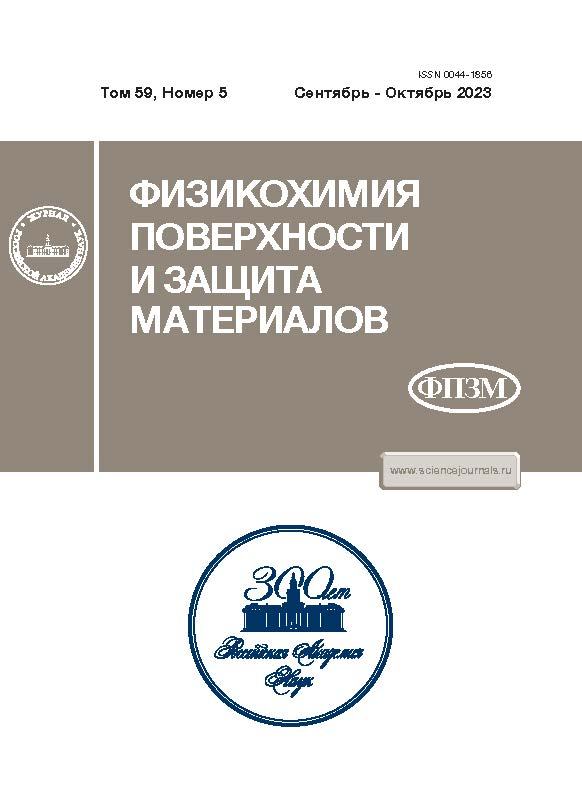Selective Sorbents Based on 2-Hydroxyethylmethacrylate and Ethylene Glycol Dimethacrylate Modified with Boric Acid as High-Affinity Ligands for Glucose
- 作者: Garkushina I.S.1, Panyuta A.S.2, Morozova P.Y.2, Osipenko A.A.2
-
隶属关系:
- Institute of Macromolecular Compounds, Russian Academy of SciencesInstitute of Macromolecular Compounds, Russian Academy of Sciences
- Institute of Macromolecular Compounds, Russian Academy of Sciences
- 期: 卷 59, 编号 5 (2023)
- 页面: 506-516
- 栏目: ФИЗИКО-ХИМИЧЕСКИЕ ПРОЦЕССЫ НА МЕЖФАЗНЫХ ГРАНИЦАХ
- URL: https://kld-journal.fedlab.ru/0044-1856/article/view/663928
- DOI: https://doi.org/10.31857/S0044185623700614
- EDN: https://elibrary.ru/VFENJM
- ID: 663928
如何引用文章
详细
A synthesis method of granulated polymeric sorbents based on 2-hydroxyethylmethacrylate and ethylene glycol dimethacrylate that possess affinity to glucose sorption sites formed by boric acid molecules has been developed. The participation of boric acid as an additional crosslinking agent and the effect of the amount of the introduced ligand on the surface morphology of the granules and physicochemical properties of the polymeric sorbents have been determined. It has been found that this modification of the polymer matrix promotes an increase in the affinity of the sorption surface and its adsorption capacity to bind glucose in a dynamic mode, as well as high selectivity in comparison with the sorption of its structural analogue, fructose. This can further be used in the development of a method of isolation of glucose from a multicomponent solution and a sorption method of separation of sugars.
作者简介
I. Garkushina
Institute of Macromolecular Compounds, Russian Academy of SciencesInstitute of Macromolecular Compounds, Russian Academy of Sciences
Email: irin-g16@yandex.ru
199004, St. Petersburg, Russia
A. Panyuta
Institute of Macromolecular Compounds, Russian Academy of Sciences
Email: irin-g16@yandex.ru
199004, St. Petersburg, Russia
P. Morozova
Institute of Macromolecular Compounds, Russian Academy of Sciences
Email: irin-g16@yandex.ru
199004, St. Petersburg, Russia
A. Osipenko
Institute of Macromolecular Compounds, Russian Academy of Sciences
编辑信件的主要联系方式.
Email: irin-g16@yandex.ru
199004, St. Petersburg, Russia
参考
- Ning H. et al. // J. Chromatogr. A. 2022. V. 1671. P. 462994.
- Hasanah A.N. et al. // J. Chem. Hindawi Limited. 2020. V. 2020. ID 7282415
- Tu X. et al. // Talanta. 2021. V. 226. P. 122142.
- Alipour S. et al. // J. Mater. Res. Technol. 2021. V. 12. P. 2298–2306.
- Eivazzadeh-Keihan R. et al. // TrAC Trends Anal. Chem. 2021. V. 141. P. 116291.
- Xu R. et al. // J. Chromatogr. A. 2021. V. 1635. P. 461707.
- Hu Z., Wang X., Chen X. // Anal. Chim. Acta. 2020. V. 1112. P. 16–23.
- Gheybalizadeh H., Hejazi P. // React. Funct. Polym. 2022. V. 171. P. 105152.
- Amorim M.S., Sales M.G.F., Frasco M.F. // Biosens. Bioelectron. 2022. V. 10. P. 100131.
- Li M. et al. // Kexue Tongbao/Chinese Science Bulletin. 2019. V. 64. № 13. P. 1321–1329.
- Askin S., Kizil S., Bulbul Sonmez H. // React. Funct. Polym. 2021. V. 167. P. 105002.
- Bayraktaroglu S., Kizil S., Bulbul Sonmez H. // J. Environ. Chem. Eng. 2021. V. 9. № 5. P. 106002.
- Sulejmanović J. et al. // Chemosphere. 2022. V. 296. P. 133971.
- Wang H.H., Shyr T.W., Hu M.S. // J. Appl. Polym. Sci. 1999. V. 74. № 13. P. 3046–3052.
- Prosanov I.Y. et al. // Mater. Today Commun. 2018. V. 14. P. 77–81.
- Hong X. et al. // J. Appl. Polym. Sci. 2021. V. 138. № 47.
- Vedelago J. et al. // Sci. Reports. 2021. V. 11. № 1. P. 1–14.
- Belcher R., Tully G.W., Svehla G. // Anal. Chim. Acta. 1970. V. 50. № 2. P. 261–267.
- Dawber J.G., Matusin D.H. // J. Chem. Soc. Faraday Trans. 1982. V. 78. № 8. P. 2521–2528.
- Crabb W.D., Mitchinson C. // Trends Biotechnol. 1997. V. 15. № 9. P. 349–352.
- Kuznetsov B.N. et al. // Катализ в промышленности. 2017. V. 17. № 6. P. 543–553. (In Russ.).
- Dupont H. et al. // Macromolecules. 2021. V. 54. № 11. P. 4945–4970.
- Yang Y. et al. // Frontiers in Pharmacology. 2017. V. 8. № MAY. P. 287.
- Willaman J.J., Davison F.R. // J. Agric. Res. 1924. V. 28. № 5. P. 479–487.
- Umpleby R.J. et al. // Journal of Chromatography B: Analytical Technologies in the Biomedical and Life Sciences. 2004. V. 804. № 1. P. 141–149.
- Hinz C. // Geoderma. 2001. V. 99. № 3–4. P. 225–243.
- Freundlich H. // Zeitschrift für Phys. Chemie. 1907. V. 57U. № 1. P. 385–470.
- Ebadi A., Soltan Mohammadzadeh J.S., Khudiev A. // Adsorption. 2009. V. 15. № 1. P. 65–73.
- Ebadi A., Soltan Mohammadzadeh J.S., Khudiev A. // Chem. Eng. Technol. 2007. V. 30. № 12. P. 1666–1673.
- Krishna Kumar A.S., Jiang S.J., Tseng W.L. // J. Mater. Chem. A. 2015. V. 3. № 13. P. 7044–7057.
- Malarvizhi R., Sulochana N. // J. Environ. Prot. Sci. 2008. V. 2. P. 40–46.
- Liu Y. // Colloids Surfaces A Physicochem. Eng. Asp. 2006. V. 274. № 1–3. P. 34–36.
- Giles C.H., Smith D., Huitson A. // J. Colloid Interface Sci. 1974. V. 47. № 3. P. 755–765.
- Boyd G.E., Adamson A.W., Myers L.S. // J. Am. Chem. Soc. 1947. V. 69. № 11. P. 2836–2848.
- Lagergren S. // Springer-Verlag. 1907. V. 2. № 1. P. 15.
补充文件
















